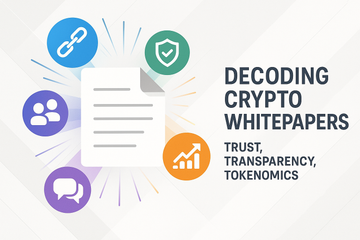Feel like you've been hearing the word 'whitepaper' tossed around every time someone mentions the next big crypto project? You’re not alone. Like, does anyone actually read these things? Turns out—yes. And if you’re not, you might be missing out on some of the juiciest details (and red flags!) a project’s got to offer. There’s a lot more to a whitepaper than charts, jargon, and the occasionally overzealous promise of “changing everything.” So, let’s break it all down.
So, What’s a Whitepaper Anyway?
The easiest way to think about a whitepaper: it’s the crypto world’s version of a pitch meeting, combined with a technical manual and sprinkled with ambitious vision. Someone’s trying to sell you on an idea—but they also want to convince the math nerds and security buffs that it’s genuine and bulletproof. Dig deep enough, and you’ll find these documents in other industries too—software, biotech, even government policy. Still, crypto whitepapers hold a distinct vibe.
In a nutshell? A whitepaper offers up all the crucial information about a project: problem, solution, how the tech works, why it matters, and—often—the dreaded “tokenomics” section that explains how (and if) you might actually make money.
But here’s the thing: a whitepaper can be as formal as a scientific treatise, or as creative as a startup dreamscape. Sometimes they're peppered with analogies (like 'our protocol is the Swiss Army knife for DeFi'), and other times, they’re dry as a law book. You just never know until you crack one open.
Why All the Hype? The Real Function of Whitepapers
Alright, so why does everyone fixate on these documents? Because in crypto—and especially when it comes to things like Bitcoin or Ethereum—whitepapers are the bedrock. They’re the trust builders. Before Satoshi Nakamoto dropped Bitcoin’s original whitepaper in 2008, the idea of decentralized digital currency was more science fiction than reality. That document wasn’t just a technical proposal; it lit the fuse that sparked an entire industry.
Whitepapers serve three key purposes:
- Transparency (or at least a promise of it): Investors, developers, and curious onlookers all expect to see the project’s inner workings. If you can’t explain how your nifty blockchain works in a whitepaper, should anyone really trust you?
- Roadmap for Devs: Developers need blueprints. A whitepaper doubles as a blueprint—something practical and concrete to build from. Sure, it might change over time (they often do), but without a starting point, it’s just vibes.
- Community Magnet: Crypto projects live and die by their communities. A killer whitepaper doesn’t just lure in investment—it invites conversation, collaboration, and sometimes, friendly (or not-so-friendly) debate.
Ever got FOMO reading about a new project because everyone on your timeline was hyping it up? Bet they were quoting—or misquoting—the whitepaper.
What Actually Goes Into One? Not Just Numbers and Nerd-Talk
Okay, now for the nuts and bolts. While there’s no one-size-fits-all template, most whitepapers cover some core territory. You’ll see sections like:
- Problem Statement: What’s broken? Where’s the gap?
- Solution: How’s this protocol, token, or app going to fix it?
- Technical Overview: Here’s where the devs get excited—algorithms, consensus mechanisms, and security features galore.
- Tokenomics: How’s the native asset distributed, used, or staked? Is it inflationary or capped, like Bitcoin?
- Roadmap: What’s next? Any launch timelines or milestones?
- Team and Advisors: Who’s behind all this magic? Real humans, we hope!
Some projects, like those behind heavyweights Trezor or Ledger wallets, even throw in dedicated security sections, outlining how they keep your digital riches safe from hackers and slip-ups. (And if they don’t, maybe skip the download.)
Crypto Skeptics and True Believers: Who Reads These Things?
Here’s an underrated truth: not everyone pores over whitepapers, cover to cover. Sometimes, people want to get straight to the point. Others geek out on pages of Merkle trees and zero-knowledge proofs like it’s their weekend hobby. There’s no shame either way, but if you’re serious—even a casual investor—it pays to at least skim. You’d be surprised how much you can pick up in just a few minutes. Maybe just focus on the summary and security aspects (especially with hardware wallet integrations) before diving into tokenomics—or, you know, before tossing your rent money into the winds of crypto hope.
Honest moment: There’s a trend where some projects try to dazzle (or daze?) with buzzwords—blockchain, interoperability, decentralized ledger, you name it. That’s when it pays to have your nonsense radar on. If you walk away confused or unconvinced, trust your gut. Great whitepapers don’t hide behind smoke and mirrors.
Whitepapers Gone Rogue? Some Pitfalls and Perks
Not every whitepaper is a work of art. In fact, some are the digital equivalent of a get-rich-quick brochure. It’s a tale as old as crypto itself—projects hyping vaporware, plagiarizing content, or promising moon landings without a rocket. Take the time to fact-check, poke around online communities, and don’t be afraid to ask silly questions (there are no real silly questions in crypto, trust me).
Yet, when done right, whitepapers end up as reference points. Teams look back at what they promised, devs argue about features, and even regulators use them to sniff out fraud or misconduct. There’s even a rich culture forming around analyzing, reviewing, and, yes, even meme-ing whitepapers. Some communities wear Trezor and Ledger whitepapers like badges of honor—they trust the project because the docs delivered.
Reading Between the Lines (and Hype!)
Maybe you’re not a cryptography ace, or you find technical diagrams about as exciting as a tax return. That’s all right. Reading a whitepaper is a bit like checking a restaurant’s kitchen before you order. Sure, you trust the chef—but you’d like to know the food’s not microwave-safe plastic. Rather than feeling overwhelmed, find one section you care about. Maybe you’re passionate about environmental sustainability—scan for eco-friendly bits. Obsessed with privacy? Find the security talk and see if they name-drop industry leaders like Trezor or Ledger. Honestly, most people cherry-pick anyway.
And here’s a fun tidbit: Some whitepapers have gone straight-up viral. Think the original Bitcoin whitepaper or Ethereum’s—those are studied, picked apart, and referenced across academia and fintech alike. They’re kind of like rock albums for the tech crowd.
Future of Whitepapers: Are They Here to Stay?
Now, with TikTok attention spans and meme coins galore, are whitepapers still relevant? You bet. If anything, they’re evolving. Projects now deliver multimedia whitepapers—animated explainers, live demos, and even interactive docs. But that core promise hasn’t changed: transparency, ambition, and a touch of “here’s why you should give a darn.”
So next time someone mentions a whitepaper, pause before you scroll past. It’s more than a PDF dump or a token sales pitch. It’s the front door of the crypto clubhouse—sometimes tidy, sometimes a mess, always full of clues about whether you’ll want to stick around.
And who knows? Maybe the next whitepaper you skim could lead you to a game-changer—or just a good story for your group chat. Either way, that’s crypto for you. Curious, chaotic, and—above all—always evolving.











